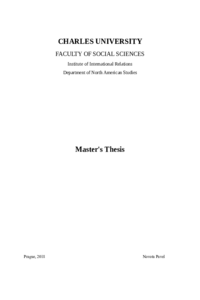Women on the Periphery: The Invisible Empire Reborn
Ženy na pomezí: znovuzrození neviditelného impéria
diplomová práce (OBHÁJENO)

Zobrazit/
Trvalý odkaz
http://hdl.handle.net/20.500.11956/102483Identifikátory
SIS: 188413
Kolekce
- Kvalifikační práce [17632]
Autor
Vedoucí práce
Oponent práce
Sehnálková, Jana
Kýrová, Lucie
Fakulta / součást
Fakulta sociálních věd
Obor
Americká studia
Katedra / ústav / klinika
Katedra severoamerických studií
Datum obhajoby
18. 9. 2018
Nakladatel
Univerzita Karlova, Fakulta sociálních vědJazyk
Angličtina
Známka
Výborně
Klíčová slova (česky)
Ku Klux Klan, KKK ve 20. letech 20. století, rasismus v USA, ženy v Ku Klux KlanuKlíčová slova (anglicky)
Ku Klux Klan, KKK in the 1920s, racism in the U.S, women in the Ku Klux KlanNásledující diplomová práce se zabývá rolí žen v americkém Ku Klux Klanu v období tzv. zlatých dvacátých let dvacátého století, především v jeho první polovině. Autor se pokusí zaměřit na následující aspekty této problematiky: hlavním cílem bude prokázat, že vznik a vůbec samotná existence ženské pobočky Klanu poukazuje na vnitřní ambivalence tohoto hnutí a je tedy jistou sondou do veškerých problémů KKK, ať už se týkaly financí, členství, soudních sporů atp. Za druhé bude cílem ověřit, zda a do jaké míry ženské členky legitimizovaly Klan, ať už z hlediska veřejného mínění anebo samotných struktur Ku Klux Klanu. Zároveň bude snahou autora práce o to, aby přes působení ženské pobočky Klanu (tzv. WKKK) poukázal na to, že Ku Klux Klan nelze chápat apriorně chápat jako agresivní rasistickou organizaci, ale jako skupinu, která se cítila být ohrožena "venkovním" světem, před kterým se bránila. Z tohoto důvodu bude kladen značný důraz na společenské prvky, tzn. samotné fungování Klanu, pozice žen v něm, charitativní aspekty hnutí a snaha zasahovat do lokálního života. Posledním bodem je rovněž rovina primárních pramenů, které nesou silně subjektivní prvky a jejichž obsah se mnohdy nekryl s realitou. Spisy členů a členek Klanu jsou zabarveny strachem a obavami ze "druhého", kdežto novinové články či reakce...
The thesis examines the role of women in the Ku Klux Klan in the early 1920s. The author seeks to analyze the following aspects: the main goal is to prove that the foundation and the very existence of the women's auxiliary (WKKK) points to inner tensions within the movement. The WKKK, therefore, can be used as a model or a case study in order to highlight all the issues the Klan had to face, from financial struggles and various allegations to transient and unstable membership. Secondly, the author sets out to verify whether and to what degree WKKK members legitimized the Klan, be it from the outside (public opinion) or from the inside. The author also places emphasis on the fact that the Klan should not be primarily viewed as a violent racist organization, but as a group of members who felt threatened by the outside world from which they needed to shelter themselves. Social life of the Klan and what role Klanswomen had, charity work, or interventions in local affairs play a vital role in this thesis as a result. Last but not least, proper understanding of primary sources is essential. They are obviously highly subjective and serve as a prime example of how reality differed from what was stated. (W)KKK pamphlets and writings were colored by fear of the so-called "other". Most texts written by...
